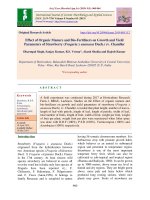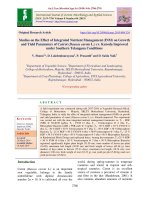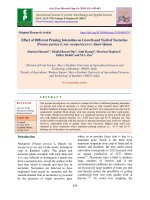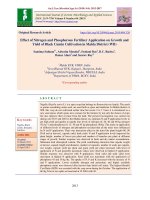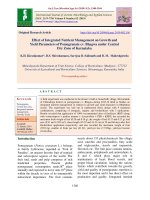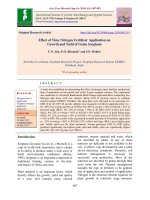Effect of shoot pruning on growth and yield of guava (Psidium guajava L.) cv. L-49 under foothills of Arunachal pradesh
Bạn đang xem bản rút gọn của tài liệu. Xem và tải ngay bản đầy đủ của tài liệu tại đây (239.37 KB, 8 trang )
Int.J.Curr.Microbiol.App.Sci (2019) 8(3): 2020-2027
International Journal of Current Microbiology and Applied Sciences
ISSN: 2319-7706 Volume 8 Number 03 (2019)
Journal homepage:
Original Research Article
/>
Effect of Shoot Pruning on Growth and Yield of
Guava (Psidium guajava L.) cv. L-49 under Foothills of Arunachal Pradesh
Hau Ngaih Lian*, Barun Singh, Bidyarani Devi Senjam and Md. Ramjan
Central Agricultural University, College of Horticulture & Forestry,
Pasighat, Arunachal Pradesh, India
*Corresponding author
ABSTRACT
Keywords
Winter guava,
Pruning intensity,
Pruning time,
Growth
Article Info
Accepted:
15 February 2019
Available Online:
10 March 2019
The effects of pruning months (mid-April, mid-May and mid-June) and pruning severity
(pruning of 25%, 50% and 75% of shoot length from tip) on growth and yield of guava cv.
L- 49 planted at a spacing of 6 m x 6 m at Fruit Research Farm, Department of Fruit
Science, College of Horticulture, Pasighat, Arunachal Pradesh during April 2017 to
December 2017, with an aim to optimize the time of pruning and intensity of pruning for
harvesting of winter guava crop. Among different months of shoot pruning, pruning in
mid-April (M1) was found to be the best for promoting plant growth parameters like plant
height, collar girth, E-W and N-S canopy spread, length of shoot, fruit set and number of
fruits/plant, whereas the maximum fruit yield (kg/tree) was recorded highest in mid-May
pruning. The intensity of pruning in respect of length of shoot pruning also had different
responses. On the basis of overall performance the study clearly revealed that pruning of
25% of the shoot length in mid-April (P1M1) was found to be the best treatment among all
plant growth parameters, whereas pruning of 50% of the shoot length in mid-May recorded
best for obtaining maximum fruit yield in guava cv. L-49 for winter crop in sub-tropical
climatic conditions under the foot hills of Arunachal Pradesh.
Introduction
Guava (Psidium guajava L.) the “apple of the
tropics” or “poor man’s apple” is one of the
most popular fruit crop of tropical and subtropical climate belonging to Myrtaceae
family 13Radha and Mathew, (2007). It is the
third richest source of Vitamin C (299
mg/100g) after Barbados cherry (1000-4000
mg/100 g pulp) and aonla (600 mg/100g of
pulp) 5Gupta (2014), contains 2 to 5 times
more vitamin C than oranges and 10 times
more than tomato. Guava bears fruit on
current season’s shoot and flowers appear in
solitary or in cymes of two or three in the axil
of leaves. Pruning of guava is one of the most
important practices that influence the vigour,
productivity and quality of the fruits. Pruning
at an early stage is done to develop a strong
framework and capable for bearing a heavy
crop load.
The main advantages of pruning on bearing
trees include the formation of new shoots,
avoid overcrowding of branches, removal of
criss-cross branches, diseased branches as
2020
Int.J.Curr.Microbiol.App.Sci (2019) 8(3): 2020-2027
well as water sprouts and root suckers. In a
humid and high rainfall area like Arunachal
Pradesh, crop regulation of guava by using
chemicals and growth regulators such as
Urea, NAA, etc. are not much effective
because the plant do not go into dormancy
due to abundant rainfall received in this area
which starts from the month of March.
Therefore, pruning could prove to be the most
effective method for eliminating rainy season
crop and production of winter season guava.
If the guava tree is left unpruned, they tend to
prolong the vegetative growth, reduce the
bearing area, thus leading to decrease in fruit
size, yield and quality. Hence, to get a good
balance between the vegetative and
reproductive growth, pruning becomes
essential. Therefore, the present investigation
aims to optimize the extent to which guava
trees should be pruned and to standardize the
most appropriate time for pruning of guava
for winter production under the foothills of
Arunachal Pradesh.
Materials and Methods
The study was carried out in the experimental
field of Fruit Research Farm, Department of
Fruit Science, College of Horticulture,
Pasighat, Arunachal Pradesh, Central
Agricultural University, during 1st April 2017
to December 2017. Seven years old guava
orchard of cv. L- 49 (Sardar) planted at a
spacing of 6 m x 6 m were selected for the
research work. The treatment consists of three
different time of pruning (mid-April, midMay and mid-June) and three different levels
of pruning intensities (pruning of 25%, 50%
and 75% of shoot length from the tip). The
experiment
comprising
9
treatment
combinations was laid out in 2-factor
Factorial Randomized Block Design (f-RBD)
having three replications. For each treatment
combination two uniform plants were
selected. The treatment details are as follows:
Factor -1 (pruning time)
M1 = mid – April pruning
M2 = mid – May pruning
M3 = mid – June pruning
Factor – 2 (pruning severity)
P1 = Pruning of 25% of the shoot length from
tip
P2 = Pruning of 50% of the shoot length from
tip
P3 = Pruning of 75% of the shoot length from
tip
Treatment combinations
T1 = P 1 M 1
−Pruning
length in mid- April
T2 = P2 M1
−Pruning
length in mid- April
T3 = P 3 M 1
−Pruning
length in mid- April
T4 = P 1 M 2
−Pruning
length in mid- May
T5 = P2 M2
−Pruning
length in mid- May
T6 = P 3 M 2
−Pruning
length in mid- May
T7 = P1 M3
−Pruning
length in mid- June
T8 = P1 M3
−Pruning
length in mid- June
T9 = P 3 M 3
−Pruning
length in mid- June
of 25% of the shoot
of 50% of the shoot
of 75% of the shoot
of 25% of the shoot
of 50% of the shoot
of 75% of the shoot
of 25% of the shoot
of 50% of the shoot
of 75% of the shoot
The guava trees were pruned according to the
treatment details. Pruning was done with the
help of secateurs and pruning saw and all the
leaves were completely defoliated at the time
of pruning. The cut ends were smeared with a
paste of Copper oxychloride in vegetable oil
(crude palm oil). A common dose of
fertilizers (N-500 g + P205 - 200 g + K20-500
g) and 40 Kg FYM per plant per year was
applied. A full dose of FYM and P205 was
2021
Int.J.Curr.Microbiol.App.Sci (2019) 8(3): 2020-2027
applied at the time of imposition of treatment.
Nitrogen and K20 were applied in 2 split
doses. The first dose of N and K20 was
applied along with FYM + P205 and the
second was applied during the second week of
September. The plant protection and other
cultural operations were uniformly given as
and when required. The observations were
recorded for its change in vegetative growth
parameters like increase in plant height, collar
girth, canopy spread (both E-W and N-S
directions), first vegetative bud burst, number
of fruit per plant and fruit yield (kg/plant).
The means of all the treatments of the
observations were analysed statistically by
ANOVA using 15OPSTAT software and the
significance of the results are verified.
2
Basu et al., (2007) and 16Singh et al., (2001).
Singh et al., (2001) further concluded that
pruning might shift the allocation of
metabolites from rainy season crop in favour
of increased vegetative growth due to flower
and fruitlet removal as a result of pruning.
Thus, the vegetative growth of guava seems
to respond to variation in month of pruning
operation. With an increase in severity of
pruning the increase in plant height was less.
7
Kumar and Rattanpal (2010) stated that this
may be due to the fact that pruned trees were
unable to make up the loss of growth caused
by severe pruning in this short period. Similar
views were reported by 11Mahesh et al.,
(2016) and 6Kohli et al., (2017) in guava.
16
Collar girth (cm)
Results and Discussion
Plant height (cm)
The effect of different level of pruning time
had a significant influence on the increase in
plant height. The maximum plant height
(50.22 cm) was recorded in M1 (mid-April
pruning) while the minimum (45.72 cm) was
recorded in M3 (mid-June pruning). With
respect to the intensity of pruning, the
maximum increase in height (56.56 cm) of the
plant was recorded in P1 (pruning of 25% of
the shoot length) and minimum (40.11 cm) in
P3 (pruning of 75% of the shoot length). As
regards to interactions, the maximum increase
in height of the plant (59.00 cm) was recorded
in the treatment P1M2 (pruning of 25% of the
shoot length in mid-May) which was at par
(57.00 cm) with P1M1 (pruning of 25% of the
shoot length in mid-April) and the minimum
(39.00 cm) was in P3M3 (pruning of 75% of
the shoot length in mid-May).
In the present investigation, it was observed
that early pruning result in more plant growth
vice versa late pruning decrease the shoot
growth. Similar findings were reported by
The data presented in table 1 indicate that the
collar girth was influenced by the effect of
time of pruning. The maximum increase in
collar girth (2.60 cm) was recorded in M1
(mid-April pruning) which was significantly
higher than M3 (mid June pruning) and at par
with M2. As regards to different levels of
pruning intensity of pruning, there was
statistically no significant difference in
increase in collar girth.
From the data it is clear that early pruning
increases the stem girth than late pruning. The
results are parallel with the findings of
12
Meena et al., (2016) where they reported
that the maximum increase in basal
circumference of the stem was recorded when
plants were pruned in the month of April.
This may be due to the shift of metabolites
from flowering sites to new vegetative growth
sites influencing the increase in the stem
circumference of the tree. Similar kind of
observation was also reported by 10Lotter
(1990) in relation to pruning experiment on
Fan Retief Guava cultivar.
2022
Int.J.Curr.Microbiol.App.Sci (2019) 8(3): 2020-2027
Canopy spread
East-West direction
The maximum increase (109.22 cm) in
canopy spread (E-W direction) under the
influence of different time of pruning was
recorded in M1 (mid-April pruning) which
was at par with M2 (mid May pruning) and
lowest (99.67 cm) in M3 (mid-June pruning).
With respect to different pruning intensity, the
maximum increase (114.78 cm) was recorded
in P1 (pruning of 25% of the shoot length) and
lowest (92.44 cm) in P3 (pruning of 75% of
the shoot length). The interaction between
time of pruning and intensity of pruning did
not have significant influence on the canopy
spread in E-W direction. However, the
maximum increase (119.33 cm) was recorded
in M1P1 (pruning of 25% of the shoot length
in mid-April).
The results of the present investigation depict
that early and lower level of pruning
enhanced the canopy spread in E-W direction.
However, the interaction effect between time
and intensity of pruning showed nonsignificant effect on the canopy spread in
East-West direction. Increase in the canopy
spread may be due to the increase in shoot
length leading to increase in canopy spreading
12
Meena et al., (2016).
North-South direction
Canopy spread (N-S direction) recorded a
significant increase under the influence of
different time of pruning and pruning
intensity. The maximum increase (109.33 cm)
in canopy spread was recorded with the
treatment M1 (mid-April pruning) and lowest
(95.28 cm) in M3 (mid-June pruning). With
respect to different pruning intensity, the
maximum increase in the canopy spread
(117.11 cm) was recorded in P1 (pruning of
25% of the shoot length) and lowest (93.44
cm) in P3 (pruning of 75% of the shoot
length). The interaction effect between time
and intensity of pruning depicted a significant
influence on the canopy spread in N-S
direction. The maximum increase (123.33 cm)
was recorded in P1M2 (pruning of 25% of the
shoot length in mid-May). The results of the
present findings are in line with the findings
of 11Mahesh et al., (2016) who stated that
mild pruning (25% of the length shoot)
initiated towards the end of summer with
plants getting sufficient period of rest
followed by pruning and irrigation resulted in
profuse growth. These findings corroborate
with views of 17Sundarajan and Muthuswamy
(1966) who opined that mild pruning by
tipping had increased numbers of functionary
laterals in guava. Similar results were also
reported by 1Ansari et al., (2011) in citrus
species and 8Lal et al., (2000) in mango.
Time of first vegetative bud burst (days
from imposition of treatment)
The data on differences in pruning time
revealed, earliest emergence (5.44 days)
vegetative bud burst in P1 (mid-April pruning)
and maximum (6.79 days) in M3 (mid-June
pruning). With respect to the intensity of
pruning, the minimum time (5.43 days) taken
for vegetative bud burst was in P3 (pruning
75% of the shoot length) and maximum (6.55
days) in P1 (pruning of 25% of the shoot
length). As regards to the interactions, the
minimum days (4.90 days) for bud burst were
in P3M1 (pruning 75% of the shoot length in
mid-April) and maximum (7.50 days) in P1M3
(pruning 25% of the shoot length in midJune).
New shoots emerged early by early pruning.
This may be due to removal of apical
dominance. Similar finding were reported by
2
Basu et al., (2007) who stated that the
increase in severity of pruning encouraged
early vegetative bud emergences. The result
2023
Int.J.Curr.Microbiol.App.Sci (2019) 8(3): 2020-2027
of the present finding is similar to the findings
of 3Bhagawati et al., (2015) where they stated
that in severe pruning, more nutrients
available to vegetative bud and also may be
due to more light interception that induces
early sprouting of vegetative buds.
Length of shoots (cm)
In the present investigation, it was observed
that the difference in time of pruning had a
significant influence on shoot length. The
maximum length of shoot (23.67 cm) was
recorded in M2 (mid-May pruning) which was
at par (23.11 cm) with M1 (mid-April pruning)
and lowest (20.89 cm) in M3 (mid-June
pruning). With regard to the intensity of
pruning the maximum length of shoots (24.62
cm) was recorded in P3 (pruning of 75% of
the shoot length) which was at par with P2
(pruning of 50% of the shoot length) whereas
the minimum (20.98 cm) was recorded in P1
(pruning of 25% of the shoot length). The
interaction between time and level of pruning
showed non-significant result. However, the
maximum mean shoot length (25.67 cm) was
recorded in P3M2 (pruning of 50% of the
shoot length in mid-May).
The results revealed that the shoot length
increased up to May pruning and later
decrease with delay in pruning time.
However, with the increase in severity of
pruning the shoot length increased. This may
be attributed due to relatively less number of
shoots and availability of more nutrients per
shoots 3Bhagawati et al., (2015).
Fruit set (%)
The fruit set was not influenced due to
difference in time of pruning. However, the
highest percentage of fruit set (79.22 %) was
obtained in treatment M2 (mid-May pruning)
and lowest (75.28%) was observed in M3
(mid-June pruning). Under the influence of
pruning intensity maximum fruit set (79.63%)
was recorded in P1 (pruning of 25% of the
shoot length) which was at par with P2
(pruning of 50% of the shoot length) and least
in P3 (pruning of 75% of the shoot length).
The interaction of pruning time and pruning
intensity showed significant influenced on
fruit set. The maximum fruit set (83.33%) was
recorded in P2M2 (pruning of 50% of the
shoot length in mid-May) and 83.00% in
P1M2 (pruning of 25% of the shoot length in
mid-May) and lowest (68.67 %) in P3M3
(pruning of 75% of the shoot length in midJune).
The fruit set percentage decreased with
increase in intensity of pruning. This may be
due to the fact that light pruning increased the
reproductive growth as compared to severe
pruning and severely pruned trees gave rise to
more vegetative growth. Similar findings
were reported by 14Sah et al., (2017) and
11
Mahesh et al., (2016).
Number of fruit per plant
The highest number of fruit per plant (172.78)
was recorded in M1 (mid-April Pruning)
which was at par (163.11) with M2 (mid-May
pruning) due to the effect of time of pruning.
Under the influence of pruning intensity, the
maximum number of fruit per plant (154.56)
was recorded in P2 (pruning of 50% of the
shoot length) which was at par (151.00) with
P1 (pruning of 25% of the shoot length) and
least (130.78 fruits) in P3 (pruning of 75% of
the shoot length).
The interaction between the two factors also
showed significant influence over the number
of fruit. The maximum number of fruit
(192.00) was obtained in P2M1 (pruning of
50% of the shoot pruning in mid-April) and
least (90.00) in P3M3 (pruning of 75% of the
shoot length in mid-June).
2024
Int.J.Curr.Microbiol.App.Sci (2019) 8(3): 2020-2027
Table.1 Effect of pruning time and pruning severity on growth and yield of winter guava under foothills of Arunachal Pradesh
Treatment
Month of pruning
M1
M2
M3
SE(m)±
CD(0.05)
Intensity of
pruning
P1
P2
P3
SE(m)±
CD(0.05)
Interaction (P x M)
P1M1
P2M1
P3M1
P1M2
P2M2
P3M2
P1M3
P2M3
P3M3
SE(m)±
CD(0.05)
Increase in
plant
height (cm)
Increase
in collar
girth
(cm)
Increase in canopy
spread (cm)
E-W
N-S
Time taken Length of
for first
shoots
vegetative
(cm)
bud burst
(days)
Fruit set
(%)
Number of
fruit/plant
Fruit yield
(kg/plant)
50.22
48.61
45.72
0.813
2.457
2.60
2.28
2.11
1.21
0.367
109.33
106.33
99.67
2.56
7.741
109.33
105.17
95.28
1.88
5.71
5.44
5.73
6.79
0.201
0.608
23.11
23.67
20.89
0.749
2.264
76.59
79.22
75.28
1.339
NS
172.78
163.11
100.44
3.66
11.066
22.28
23.86
14.39
0.783
2.367
56.55
47.88
40.11
0.813
2.457
2.43
2.27
2.26
1.21
NS
114.78
108.00
92.44
2.56
7.741
117.11
99.22
93.44
1.88
5.71
6.55
6.06
5.43
0.201
0.608
20.98
22.07
24.62
0.749
1.297
79.63
78.79
72.49
1.339
4.048
151.00
154.56
130.78
3.66
11.066
19.37
22.68
18.48
0.783
2.367
57.00
49.67
44.00
59.00
49.50
37.33
53.67
44.50
39.00
1.408
4.256
2.73
2.53
2.53
2.42
2.10
2.20
2.13
2.17
2.03
0.182
NS
119.33
118.67
89.67
114.67
105.33
99.00
110.33
100.00
88.67
4.434
NS
123.00
109.67
95.33
123.33
100.67
92.50
106.00
87.33
92.50
3.27
9.89
5.70
5.73
4.90
6.23
5.63
5.33
7.50
6.80
6.07
0.348
NS
21.93
21.87
25.53
21.67
23.67
25.67
19.33
20.67
22.67
1.297
NS
75.73
76.57
77.47
83.00
83.33
71.33
80.17
77.00
68.67
2.319
7.011
180.67
192.00
145.67
160.33
172.33
156.67
112.00
99.33
90.00
6.338
19.166
18.79
27.15
20.88
24.06
26.34
21.18
15.23
14.56
13.39
1.356
4.10
M1 = mid-April pruning, M2 = mid-May pruning, M3 = mid-June pruning; P1 = pruning of 25% of shoot length, P2 = pruning of 50% of shoot length and P 3 = pruning of 75% of
shoot length; NS = Non-significant at 5 % level of significance.
2025
Int.J.Curr.Microbiol.App.Sci (2019) 8(3): 2020-2027
The number of fruit was more in early
pruning as compared to late pruning. This
may be due to higher number of fruit set in
early pruning. Parallel results were stated by
2
Basu et al., (2007). With increasing the
pruning severity decrease in fruit yield is
observed. The decrease in number of fruit per
plant is the consequence of pruning which
reduced the fruiting area and on the other
hand promoted the vegetative growth at the
expense of reproductive growth (7Kumar and
Rattanpal, 2010).
Fruit yield (kg/tree)
The effect of time of pruning on fruit yield
per tree was found to be significant. The
maximum fruit yield (23.86 kg/tree) was
recorded in M2 (mid-May pruning) which was
at par with M1 (mid-April pruning) and yield
was least (14.39 kg/tree) in M3 (mid-June
pruning). With different level of pruning
intensity the maximum fruit yield (22.68
kg/tree) was recorded in P2 (pruning of 50%
of the shoot length) and the yield due to P1
(pruning of 25% of the shoot length) and P3
(pruning of 75% of the shoot length) was
found to be at par. The interaction between
the two factors also showed significant
influence with respect to fruit yield/tree with
the maximum fruit yield (27.15 kg/tree)
recorded in P2M1 (pruning of 50% of the
shoot length in mid-April) which was par with
P2M2 (pruning of 50% of the shoot length in
mid-May).
The increase in yield during winter season
was due to elimination of rainy season crop
by shoot pruning. The present finding finds
support from the report of 4Boora et al.,
(2016) who reported that to regulate guava
crop it is essential to reduce the fruit set
during the rainy season and subsequently
increase the fruit set during the winter season
by use of different crop regulation practices
such as pruning of shoots, defoliation or
deblossoming. The results of the present
findings are in line with the recommendation
of 12Meena et al., (2016) who opined that 45
cm shoot pruning in May would be the best
for good off season production of guava.
From the present investigation, it is concluded
that shoot pruning in mid-April will be the
best treatment for eliminating rainy season
crop and enhancing the plant growth
parameters (plant height, collar girth, E-W
and N-S canopy spread, early vegetative bud
burst and length of shoots) whereas pruning
of 50% of shoot length in mid April will be
the best treatment for eliminating the rainy
season crop for better yield of guava in winter
season in the foothills of Arunachal Pradesh.
References
Ansari, A.M., Sha, A. and Ahmed, E. Studies
on rejuvenation of poor bearing citrus
plants. Prog. Agric. 2011; 11:491494.
Basu, J., Das, B., Sarkar, S., Mandal, K.K.,
Banik, B.C., Kundu, S., Hasan, M.A.,
Jha, S. and Ray, S.K. Studies on the
response of pruning for rejuvenation
of old guava orchard. Acta. Hortic.
2007; 735: 303-309.
Bhagawati, R., Bhagawati, K., Choudhary,
V.K., Rajkhowa, D.J. and Sharma, R.
Effect of pruning intensities on the
performance of fruit plants under midhill condition of Eastern Himalayas:
Case study on guava. Int. Let. Nat. Sci.
2015; 46:46-51.
Boora, R.S., Dhaliwal, H.S. and Arora, N.K.
Crop regulation in guava. Agric. Rev.
2016; 37(1):1-9.
Gupta, S.N. (2014). Instant horticulture. Jain
brothers, New Delhi, p. 206.
Kohli, K., Kumar, R., Kumar, A. and Dubey,
M.C. Effect of pruning height and
planting distance on growth and yield
of guava (Psidium guajava L.) cv.
2026
Int.J.Curr.Microbiol.App.Sci (2019) 8(3): 2020-2027
Pant Prabhat. Bioscan. 2017; 12(1):
395-398.
Kumar, Y. and Rattanpal, H.S. Effect of
pruning in guava planted at different
spacing under Punjab condition.
Indian J. Hortic. Sci. 2010; 67 (special
issue):115- 119
Lal, B., Rajput, M.S., Rajan, S. and Rathore,
D.S. Effect of pruning on rejuvenation
of old mango trees. Indian J. Hortic.
2000; 57:240-242.
Lal, S. Effect of pruning on crop regulation
in guava (Psidium guajava L.) var.
Lucknow - 49. Progress. Hortic.
1983; 7(3): 60-62.
Lotter De, J. V. Vegetative and reproductive
habit of the guava (Psidium guajava
cv. Fan Retief) in relation to pruning
methods. Acta Hortic. 1990; 275:27.
Mahesh, R.K., Jholgiker, P., Mamatha, N.P.,
Ravi, P., Shivanand, M.R. and
Kallappa, S.N. Effect of time and level
of pruning on growth and yield of
guava cv. Sardar under high density
planting. Res. Environ. Life Sci. 2016;
9(7): 849-853.
Meena, K.R., Maji. S., Kumar, S. and Verma,
S. Influence of shoot pruning for crop
regulation and Improving fruit yield of
guava. Bioscan. 2016; 11(2): 13551359.
Radha, T. and Mathew, L. Fruit crops. New
India Publishing Agency, New Delhi,
2007; Pp. 59.
Sah, H., Lal, S. and Negi, S.S. (2017). Effect
of pruning on growth, flowering and
yield in high density planting of
guava. Int. J. Pure App. Biosci., 5(1):
285-292.
Sheoran, O.P; Tonk, D.S; Kaushik, L.S;
Hasija, R.C and Pannu, R.S. Statistical
Software Package for Agricultural
Research Workers. http://14.139.232.
166/opstat/. Accessed 16 March 2018.
Singh, G., Singh, A.K. and Rajan, S.
Influence of pruning date on fruit
yield of guava (Psidium guajava L.)
under subtropics. J. Appl. Hortic.
2001; 3(1): 37-40.
Sundararajan, S. and Muthuswamy, S. Effect
of pruning on fruit size and weight in
certain varieties of guava (Psidium
guajava L.). South Indian Hortic.
1966; 14(1/4):63-64.
How to cite this article:
Hau Ngaih Lian, Barun Singh, Bidyarani Devi Senjam and Md. Ramjan. 2019. Effect of Shoot
Pruning on Growth and Yield of Guava (Psidium guajava L.) cv. L-49 under Foothills of
Arunachal Pradesh. Int.J.Curr.Microbiol.App.Sci. 8(03): 2020-2027.
doi: />
2027
